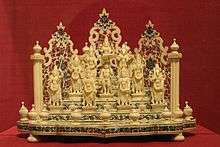Ivory Carved Dashavtar
Ivory Carved Dashavtar is a miniature Hindu shrine displaying the incarnations of Lord Vishnu intricately carved in ivory. Magnificently carved, this small ivory shrine depicts the 10 incarnations of Lord Vishnu, and is on display in the National Museum. This carved ivory shrine was made in the late 18th century.

Dashavatara of Lord Vishnu is one of the most popular concepts of Hinduism, which has been widely worshiped by the Hindus in one or the other form.[1]
History
The intricate carving and design places this shrine back to the late 18th or early 19th century. South India, used to be the hub of ivory craft, before it was banned in the country. Many artisans and craftsmen from various parts of south India (especially Trivandrum) specialized in carving ivory. Decorated with black paint, the screen and the base of the shrine shows the signature style of craftsmanship of Mysore school of ivory painting.[2]
However, ivory is a bone medium and so is forbidden to be worshiped in Hinduism. And so this raises the question as to why this shrine was carved in ivory.
Base and background
All the images are fixed on a painted stepped base made of sandalwood. The base, covered completely with ivory sheet has the traditional south Indian design of flowers and is decorated with several knobs fixed at the bottom step. Also two pillars support the fence in the background on both sides.
The backdrop of the shrine is decorated with perforated ivory screen. These Jaalidar (lattice work) screens are divided in three parts by two small European style columns. An ivory strip on the wooden edges of the steps and base of the shrine depicts the foliage pattern.
Images
There are total 10 images, each depicting Lord Vishnu's avatars, carved in ivory.
The topmost image is of the Matsya (Pisces) Avatar with four arms. The step below that holds Kurma (Tortoise) and Varaha (Boar) avatars, both with four arms. The third step has Narasimha, Vamana and Parashurama, and the images of Rama, Balarama, Krishna and Kalki incarnations are fixed on the bottom. All these images on the third and last base (except Narasimha and Kalki) have two arms.
Matsya, Kurma, Varaha, Narasimha and Kalki images are four armed, which conveys the idea of the God's supremacy. All of them hold sankha and chakra in their two hands, while the other two hands are in Abhayamudra and Varadamudra except Kalki, which holds a sword and a shield. Remaining images; Vamana, Parshurama, Rama, Balarama and Krishna are two armed and hold different attributes. Vamana holds umbrella and water vessel while Parashurama carries axe and bow. Rama holds bow and arrow and Balarama is carrying a mace with his other hand in Abhayamudra. Krishna is carrying the flute and Shankha in his two hands.
All the incarnations are wearing dhoti as a lower garment and are adorned with jewellery like necklace, bangles, armlet and kirita mukuta except Vamana, who is without a crown. Carved in round, all the images illustrate the intricate details with perfect body proportion and great aesthetic quality.
References
- Dr. Manish Kumar Dwiwedi भारतीय साहित्य एवं कला में दशावतार. कला प्रकाशन.
- Pathak, Anamika (2009). "Dasavatara Images in Ivory in the National Museum, New Delhi". Kala. 14: 111–112.